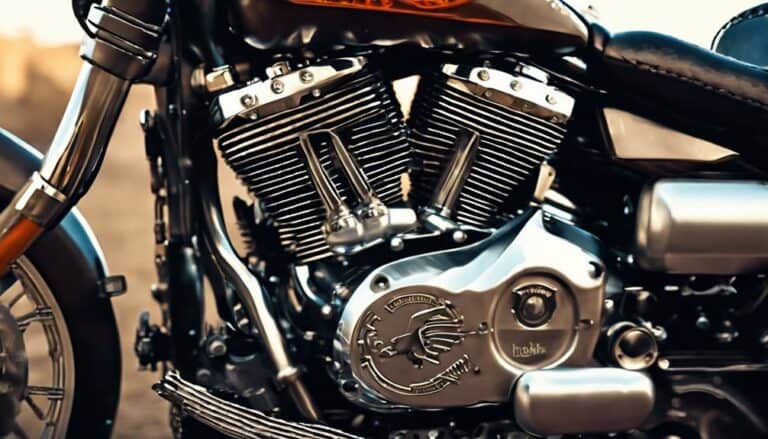Imagine you're cruising down the highway on your Harley, feeling the power beneath you and the wind in your face.
Now, consider this – what if there was a key to unlocking even more potential in your ride, a secret that could elevate your experience to new heights?
That's where Evo comes into play in the world of Harley Davidson. The mere mention of Evo conjures tales of innovation, performance, and a legacy that continues to shape the motorcycle industry.
Want to uncover the mysteries behind this iconic term and its impact on Harley enthusiasts?
Key Takeaways
- Evo in Harley Davidson signifies a revolutionary engine design introduced in 1984.
- It brought improved reliability, performance, and financial stability to Harley-Davidson.
- The Evolution Engine features aluminum construction for enhanced cooling and durability.
- Evo engines continue to define Harley's reputation for power, reliability, and performance.
Evolution Engine History
Introduced by Harley-Davidson in 1984, the Evolution engine replaced the Shovelhead engine, revolutionizing the company's lineup. The Evolution engine, commonly referred to as Evo, marked a significant shift in Harley's engine technology.
It was a V-twin engine that featured aluminum heads and cylinders, a departure from the iron components used in the Shovelhead. This change not only enhanced the engine's cooling capabilities but also contributed to its improved performance. The Evo engine was known for its reliability and durability, requiring less maintenance compared to its predecessor.
Its unique rectangular shape earned it the nickname 'Blockhead,' a testament to its innovative design. The introduction of the Evolution engine by Harley-Davidson, post the era of the Shovelhead engine, was a turning point for the company, setting a new standard in the industry and playing a pivotal role in shaping the modern Harley motorcycles.
Significance of Evo in Harley
The Evolution engine's impact on Harley-Davidson's image and financial stability in the 1980s was pivotal, solidifying its significance within the company's history. The introduction of the Evolution engine marked a turning point for Harley-Davidson, not only in terms of technological advancement but also in reshaping the brand's identity. The significance of the Evo engine lies in its role in revitalizing the company, improving the overall reliability of their motorcycles, and enhancing their performance. The aluminum construction of the Evolution engine not only provided better cooling efficiency but also increased the durability of the motorcycles, setting them apart in the industry.
| Significance of Evo in Harley | |
|---|---|
| Improved Reliability | Enhanced Performance |
| Financial Stability | Aluminum Construction |
| Revitalizing Image | Durability |
Evolution Engine Features
With its distinct 45-degree V-twin design, the Evolution engine by Harley-Davidson showcases a unique valve train configuration that sets it apart in the realm of motorcycle engineering. Unlike its predecessors like the Ironhead Sportsters, the Evolution engine features one cam per engine overhead valve, providing more precise control over valve operation. This setup, with four individual camshafts, allows for smoother power delivery and improved efficiency.
Additionally, the Evolution engine introduced blocky rocker boxes that not only contribute to its iconic appearance but also serve as a thermal conductor, aiding in heat dissipation. This design innovation enhances the engine's overall performance and durability, making it a standout feature in Harley-Davidson's lineup of Big Twins.
The Evolution engine's implementation marked a turning point for Harley-Davidson, playing a crucial role in the company's resurgence after the management buyout. Its reliability, power delivery, and distinctive design have solidified its status as a classic within the realm of motorcycle engines.
Evolution Engine Models
Evolution Engine Models showcase a diverse range of performance capabilities and design innovations across Harley-Davidson's lineup. When it comes to Harley Davidson, the Evolution engine has left its mark on various models, including the iconic Sportster and the powerful Big Twin bikes. The Sportster Evolution engine, available in 883cc and 1200cc variants, boasts a unique valve train configuration with four individual camshafts, enhancing its performance characteristics. Post-2007, Sportster Evolution engines made the switch from carburetors to fuel injection, improving fuel efficiency and throttle response. Additionally, the Evolution engine's construction with aluminum components not only aids in better cooling efficiency but also contributes to weight reduction, enhancing the overall riding experience. This engine design, with its precise cam lobes and advanced technology, has solidified its place in Harley-Davidson's legacy of producing high-performance motorcycles.
| Evolution Engine Models | Harley-Davidson Lineup |
|---|---|
| Sportster 883cc | Dyna |
| Sportster 1200cc | Softail |
| Big Twin Models | FXR |
Evolution Engine Performance
After exploring the Evolution Engine Models in Harley-Davidson's lineup, let's now examine the remarkable performance characteristics that define the Evolution Engine. Harley's Evolution engine stands out for its impressive power and performance, delivering substantial horsepower and torque that provide riders with a thrilling experience on the road. The engine's ability to generate strong acceleration and maintain high-speed stability, despite its compact size, contributes to its allure among motorcycle enthusiasts seeking a dynamic ride.
Moreover, the Evolution engine's durability is a key feature, constructed robustly to withstand challenging riding conditions. High-quality materials ensure longevity, making it a reliable choice for riders looking for an engine that can endure various terrains and weather conditions. Additionally, the engine's simple design allows for easy customization and seamless upgrades, enabling riders to enhance both performance and aesthetics according to their preferences.
Across Harley models like the Sportster 1200 and Fat Boy, the Evolution engine showcases adaptability and refined performance, making it a versatile powerhouse in the world of motorcycles.
Conclusion
So there you have it, Evo in Harley Davidson isn't just a name, it's a revolution on two wheels.
The Evolution engine transformed the Harley lineup, bringing reliability, power, and performance to a whole new level.
It's not just an engine, it's a piece of history that continues to inspire riders and enthusiasts around the world.
Ride on with Evo, and experience the evolution of Harley Davidson like never before.

